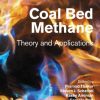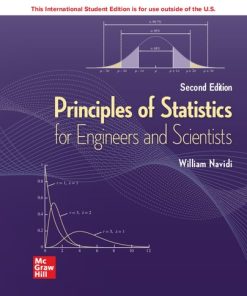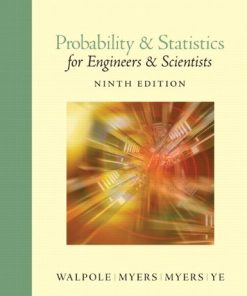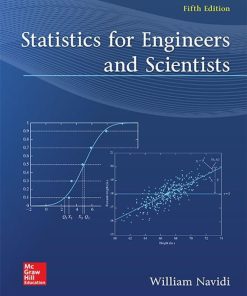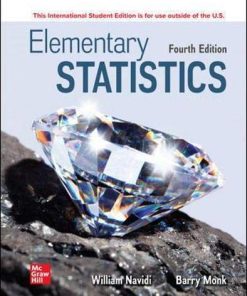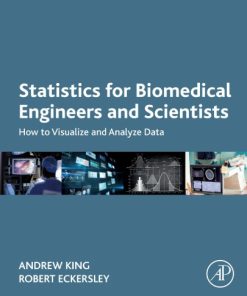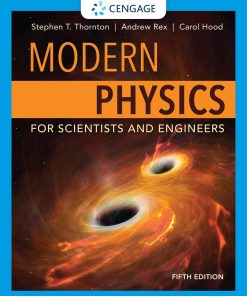(EBook PDF) Statistics for Engineers and Scientists 5th Edition by William Navidi 1259717607 978-1259717604 full chapters
$50.00 Original price was: $50.00.$25.00Current price is: $25.00.
Statistics for Engineers and Scientists 5th Edition by William Navidi – Ebook PDF Instant Download/DeliveryISBN: 1259717607, 978-1259717604
Full dowload Statistics for Engineers and Scientists 5th Edition after payment.
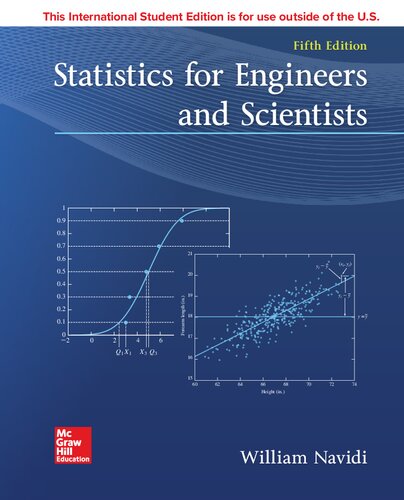
Product details:
ISBN-10 : 1259717607
ISBN-13 : 978-1259717604
Author: William Navidi
Statistics for Engineers and Scientists stands out for its crystal clear presentation of applied statistics. The book takes a practical approach to methods of statistical modeling and data analysis that are most often used in scientific work. This edition features a unique approach highlighted by an engaging writing style that explains difficult concepts clearly, along with the use of contemporary real world data sets, to help motivate students and show direct connections to industry and research. While focusing on practical applications of statistics, the text makes extensive use of examples to motivate fundamental concepts and to develop intuition.
McGraw-Hill Education’s Connect is also available. Connect is the only integrated learning system that empowers students by continuously adapting to deliver precisely what they need, when they need it, how they need it, so that class time is more effective. Connect allows the professor to assign homework, quizzes, and tests easily and automatically grades and records the scores of the student’s work. Problems are randomized to prevent sharing of answers an may also have a “multi-step solution” which helps move the students’ learning along if they experience difficulty.
Statistics for Engineers and Scientists 5th Table of contents:
Chapter 1 Sampling and Descriptive Statistics
Introduction
1.1 Sampling
1.2 Summary Statistics
1.3 Graphical Summaries
Chapter 2 Probability
Introduction
2.1 Basic Ideas
2.2 Counting Methods
2.3 Conditional Probability and Independence
2.4 Random Variables
2.5 Linear Functions of Random Variables
2.6 Jointly Distributed Random Variables
Chapter 3 Propagation of Error
Introduction
3.1 Measurement Error
3.2 Linear Combinations of Measurements
3.3 Uncertainties for Functions of One Measurement
3.4 Uncertainties for Functions of Several Measurements
Chapter 4 Commonly Used Distributions
Introduction
4.1 The Bernoulli Distribution
4.2 The Binomial Distribution
4.3 The Poisson Distribution
4.4 Some Other Discrete Distributions
4.5 The Normal Distribution
4.6 The Lognormal Distribution
4.7 The Exponential Distribution
4.8 Some Other Continuous Distributions
4.9 Some Principles of Point Estimation
4.10 Probability Plots
4.11 The Central Limit Theorem
4.12 Simulation
Chapter 5 Confidence Intervals
Introduction
5.1 Large-Sample Confidence Intervals for a Population Mean
5.2 Confidence Intervals for Proportions
5.3 Small-Sample Confidence Intervals for a Population Mean
5.4 Confidence Intervals for the Difference Between Two Means
5.5 Confidence Intervals for the Difference Between Two Proportions
5.6 Small-Sample Confidence Intervals for the Difference Between Two Means
5.7 Confidence Intervals with Paired Data
5.8 Confidence Intervals for the Variance and Standard Deviation of a Normal Population
5.9 Prediction Intervals and Tolerance Intervals
5.10 Using Simulation to Construct Confidence Intervals
Chapter 6 Hypothesis Testing
Introduction
6.1 Large-Sample Tests for a Population Mean
6.2 Drawing Conclusions from the Results of Hypothesis Tests
6.3 Tests for a Population Proportion
6.4 Small-Sample Tests for a Population Mean
6.5 Large-Sample Tests for the Difference Between Two Means
6.6 Tests for the Difference Between Two Proportions
6.7 Small-Sample Tests for the Difference Between Two Means
6.8 Tests with Paired Data
6.9 Distribution-Free Tests
6.10 Tests with Categorical Data
6.11 Tests for Variances of Normal Populations
6.12 Fixed-Level Testing
6.13 Power
6.14 Multiple Tests
6.15 Using Simulation to Perform Hypothesis Tests
Chapter 7 Correlation and Simple Linear Regression
Introduction
7.1 Correlation
7.2 The Least-Squares Line
7.3 Uncertainties in the Least-Squares Coefficients
7.4 Checking Assumptions and Transforming Data
Chapter 8 Multiple Regression
Introduction
8.1 The Multiple Regression Model
8.2 Confounding and Collinearity
8.3 Model Selection
Chapter 9 Factorial Experiments
Introduction
9.1 One-Factor Experiments
9.2 Pairwise Comparisons in One-Factor Experiments
9.3 Two-Factor Experiments
9.4 Randomized Complete Block Designs
9.5 2P Factorial Experiments
Chapter 10 Statistical Quality Control
Introduction
10.1 Basic Ideas
10.2 Control Charts for Variables
10.3 Control Charts for Attributes
10.4 The CUSUM Chart
10.5 Process Capability
People also search for Statistics for Engineers and Scientists 5th:
probability and statistics for engineers and scientists
introduction to probability and statistics for engineers and scientists
probability and statistics for engineers and scientists 10th edition
applied statistics for engineers and scientists
probability and statistics for engineers and scientists 4th edition pdf
You may also like…
Mathematics - Mathematical Statistics
Mathematics - Mathematical Statistics
Science (General)
Mathematics Mathematics - Mathematical Statistics
Probability & Statistics for Engineers & Scientists 9th Edition
Business & Economics
Medicine
Statistics for Biomedical Engineers and Scientists: How to Visualize and Analyze Data 1st Edition
Physics - General Courses
Modern Physics for Scientists and Engineers 5th Edition Stephen Thornton & Andrew Rex


